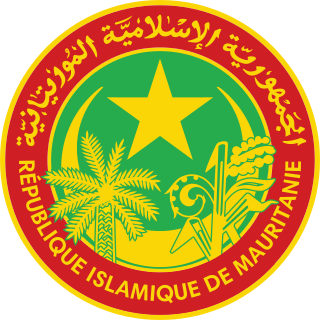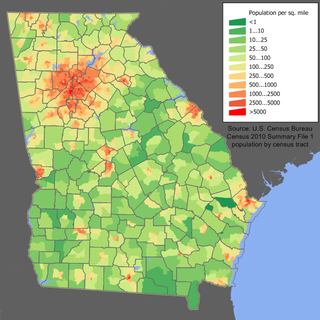Related Research Articles
Black is a racialized classification of people, usually a political and skin color-based category for specific populations with a mid- to dark brown complexion. Not all people considered "black" have dark skin; in certain countries, often in socially based systems of racial classification in the Western world, the term "black" is used to describe persons who are perceived as dark-skinned compared to other populations. It is most commonly used for people of sub-Saharan African ancestry, Indigenous Australians and Melanesians, though it has been applied in many contexts to other groups, and is no indicator of any close ancestral relationship whatsoever. Indigenous African societies do not use the term black as a racial identity outside of influences brought by Western cultures.

Lawrence County is the southernmost county located in the U.S. state of Ohio. As of the 2020 census, the population was 58,240. Its county seat is Ironton. The county was created in 1815 and later organized in 1817. It is named for James Lawrence, the naval officer famous for the line "do not give up the ship". Lawrence County is part of the Huntington–Ashland metropolitan area.

Butler County is a county located in the southwestern part of the U.S. state of Ohio. As of the 2020 census, the population was 390,357. Its county seat and largest city is Hamilton. It is named for General Richard Butler, who died in 1791 during St. Clair's Defeat. Located along the Great Miami River, it is also home to Miami University, a public university founded in 1809. Butler County is part of the Cincinnati, OH-KY-IN Metropolitan Statistical Area. The majority of the county is in District 52 of the State House.

Kenton County is a county located in the northern part of the Commonwealth of Kentucky. As of the 2020 census, the population was 169,064, making it the third most populous county in Kentucky. Its county seats are Covington and Independence. It was, until November 24, 2010, the only county in Kentucky to have two legally recognized county seats. The county was formed in 1840 and is named for Simon Kenton, a frontiersman notable in the early history of the state.

Erlanger is a home rule-class city in Kenton County, Kentucky, United States. It had a 2020 census population of 19,611. Erlanger is part of the Cincinnati-Middletown, OH-KY-IN Metropolitan Statistical Area.

Arab Americans are Americans of Arab ancestry. Arab Americans trace ancestry to any of the various waves of immigrants of the countries comprising the Arab World.
The terms multiracial people or mixed-race people refer to people who are of more than one race and the terms multi-ethnic people or ethnically mixed people refer to people who are of more than one ethnicity. A variety of terms have been used both historically and presently for mixed-race people in a variety of contexts, including multiethnic, polyethnic, occasionally bi-ethnic, Métis, Muwallad, Coloured, Dougla, half-caste, ʻafakasi, mestizo, mutt, Melungeon, quadroon, octoroon, sambo/zambo, Eurasian, hapa, hāfu, Garifuna, pardo, and Gurans. A number of these terms are now considered offensive, in addition to those that were initially coined for pejorative use. "Melezi" are called the offspring of Muslim Romani men and woman of host populations.
In the United States census, the U.S. Census Bureau and the Office of Management and Budget define a set of self-identified categories of race and ethnicity chosen by residents, with which they most closely identify. Residents can indicate their origins alongside their race, and are asked specifically whether they are of Hispanic or Latino origin in a separate question.

German Americans are Americans who have full or partial German ancestry. The 2020 census results showed over 44,978,546 Americans self-identifying as German alone or in combination with another ancestry. This includes 15,447,670 who chose German alone.

The Mauritania–Senegal Border War was a conflict fought between the West African countries of Mauritania and Senegal along their shared border from 1989 to 1991. The conflict began around disputes over the two countries' River Senegal border and grazing rights. The conflict resulted in the rupture of diplomatic relations between the two countries for several years, the creation of thousands of refugees from both sides, as well as having a significant impact on domestic Senegalese politics. Ethnic tension, political/economic crises in Senegal, and competition for natural resources between the two nations were the main underlying causes of this conflict.

The United States has a racially and ethnically diverse population. At the federal level, race and ethnicity have been categorized separately. The most recent United States census recognized five racial categories, as well as people who belong to two or more of the racial categories. The United States also recognizes the broader notion of ethnicity. The 2000 census and 2010 American Community Survey inquired about the "ancestry" of residents, while the 2020 census allowed people to enter their "origins". The Census Bureau also classified respondents as either Hispanic or Latino, identifying as an ethnicity, which comprises the minority group in the nation.

Albanian Americans are Americans of full or partial Albanian ancestry and heritage in the United States. They trace their ancestry to the territories with a large Albanian population in the Balkans and southern Europe, including Albania, Italy, Kosovo, North Macedonia and Montenegro. They are adherents of different religions and are predominantly Muslims and Christians, while some are irreligious.

Caribbean Americans or West Indian Americans are Americans who trace their ancestry to the Caribbean. Caribbean Americans are a multi-ethnic and multi-racial group that trace their ancestry further in time mostly to Africa, as well as Asia, the Indigenous peoples of the Americas, and to Europe. As of 2016, about 13 million — about 4% of the total U.S. population — have Caribbean ancestry.

Human rights in Mauritania are generally seen as poor according to international observers, including Freedom House, the United States Department of State, and Amnesty International.
Congolese Americans are Americans descended from the peoples of the Democratic Republic of the Congo and the Republic of the Congo, which consist of hundreds of ethnic groups.

Georgia is a South Atlantic U.S. state with a population of 10,711,908 according to the 2020 United States census, or just over 3% of the U.S. population. The majority of the state's population is concentrated within Metro Atlanta, although other highly populated regions include: West Central and East Central Georgia; West, Central, and East Georgia; and Coastal Georgia; and their Athens, Columbus, Macon and Warner Robins, Augusta, Savannah, Hinesville, and Brunswick metropolitan statistical areas.
Malian Americans are an ethnic group of Americans with ancestry originating in Mali. According to the US Census Bureau ancestry survey, approximately 1,800 Americans stated they had Malian ancestry, making them Malian Americans. The survey did not take into account undocumented immigrants or people who did not participate in the survey, which could mean that many more uncounted Malians live throughout the United States.
Bhutanese Americans are Americans of Bhutanese descent. According to the 2010 census there are 19,439 Americans of Bhutanese descent. However, many Nepali-Bhutanese came to the U.S. via Nepal as political refugees from that country and are registered as Nepali Americans; often leading to the actual numbers of Bhutanese Americans being underreported. More than 92,323 Bhutanese Nepalis have been resettled in the United States, with the largest single community being approximately 27,000 in Columbus, Ohio.
Cameroonian American are an ethnic group of Americans of Cameroonian descent. According to the census of 2010, in the United States there were 16,894 Americans of Cameroonian origin. According to the 2007–2011 American Community Survey there are 33,181 Cameroonian-born people living in the United States.

The Cincinnati metropolitan area is a metropolitan area with its core in Ohio and Kentucky. Its largest city is Cincinnati and includes surrounding counties in the U.S. states of Ohio, Kentucky, and Indiana.
References
- 1 2 3 4 5 6 7 "Mauritanian refugees make new home in Ohio", CNN, reported by John D. Sutter, March 17, 2012
- ↑ "Table 1. First, Second, and Total Responses to the Ancestry Question by Detailed Ancestry Code: 2000". U.S. Census Bureau. Retrieved 4 July 2013.
- ↑ U.S. Census Bureau: Selected Countries of Birth for the United States and 15 Metropolitan Statistical Areas with the Largest African-Born Populations: 2008–2012.
- ↑ Lucy M. Long (2015). Ethnic American Food Today: A Cultural Encyclopedia. Page 405.
- ↑ Mauritanian Community Association Archived 2013-10-12 at the Wayback Machine
